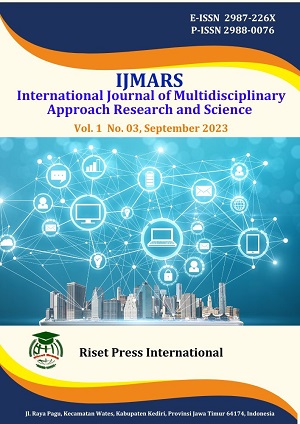Optimization of Insulin Yield from Extract of Stevia Leave (Rebaudiana Bertoni)
DOI:
https://doi.org/10.59653/ijmars.v1i03.86Keywords:
Stevia leave, Rebaudiana bertoni, InsulinAbstract
Stevia (Rebaudiana bertoni) leave, is an ancient perennial shrub mostly found in South America such as Paraguay and Brazil, it contains a low-calorie sweetener, which is about 300 times sweeter than sucrose. Insulin is a polypeptide hormone, which has an anabolic property, insulin has a vital role in regulation of carbohydrate metabolism, it also enhances the metabolism of fat and proteins and regulation of certain gene expression. Design expert software 10.0 was used to design the experimental data for the optimization of insulin yield in stevia (Rebaudiana bertoni) leave. Custom design with 3 factor and one response was applied, the independent variables were amount of stevia powder (g), volume of n-hexane (ml) and volume of ethyl acetate (ml) and the response is percentage of insulin yield (%). In this research work, insulin was successfully extracted from stevia (Rebaudiana bertoni) leave and the optimum yield was determined. The optimum extraction conditions for optimum yield of insulin were found to be: 5.668 g of stevia powder, 49.107 ml of n-hexane and 32.386 ml of ethyl acetate.
Downloads
References
Abou-Arab, E. A. ., Abou-Arab, A. A., & Abu-Salem, F. M. (2009). Physico-Chemical Assessment of Natural Sweeteners Steviosides Produced From Stevia Rebudiana Bertoni Plant. Journal of Agricultural Science, 34(12), 11037–11057.
Ahmed, L. H. (2020). Extraction of Stevioside and Rebaudioside from Fresh and Dried Stevia Leaves. Kaduna State University.
Anwer, R., Khursheed, S., & Fatma, T. (2012). Detection of immunoactive insulin in Spirulina. Journal of Applied Phycology, 24, 583–591. https://doi.org/10.1007/s10811-011-9757-1
Carley, K. M., Kamneva, N. Y., & Reminga, J. (2004). Response Surface Methodology (Issue October).
Chang, J. −C., Wu, M. C., Liu, I. −M., & Cheng, J. −T. (2005). Increase of Insulin Sensitivity by Stevioside in Fructose−rich Chow−fed Rats. Horm Metab Res, 37, 610–616. https://doi.org/10.1055/s
Ilca, V., Vukmirovica, S., Stilinovic, N., Capo, I., Arsenovi, M., & Milija, B. (2017). Insight into anti-diabetic effect of low dose of stevioside. Biomedicine & Pharmacotherapy, 90, 216–221. https://doi.org/10.1016/j.biopha.2017.03.045
Karásek, P., Pól, J., Varad, E., Roth, M., Bene, K., Kotla, P., & Josef, Č. (2007). Comparison of two different solvents employed for pressurised fluid extraction of stevioside from Stevia rebaudiana : methanol versus water. Anal Bioanal Chem, 388, 1847–1857. https://doi.org/10.1007/s00216-007-1404-y
Khann, P., Nag, T. N., & Chandrajain, S. (1976). Process of isolation of insulin from plant source. United States Patent, 57(19), 473–480.
Koona, S. J., Kudipudi, S., Sridhar, G. R., Rao, S. B., & Apparao, A. (2010). Plant insulin : An in silico approach. International Journal of Diabetes in Developing Countries, 30(4), 191–193. https://doi.org/10.4103/0973-3930.70858
Lemus-mondaca, R., Vega-gálvez, A., Zura-bravo, L., & Ah-hen, K. (2012). Stevia rebaudiana Bertoni , source of a high-potency natural sweetener : A comprehensive review on the biochemical , nutritional and functional aspects. Food Chemistry, 132(3), 1121–1132. https://doi.org/10.1016/j.foodchem.2011.11.140
M.K.Sangeetha, & Vasanthi, H. R. (2009). Plant Kingdom claims for Insulin. Sri Ramachandra Journal of Medicine, 1(1), 24–31.
Mathur, S., Bulchandani, N., Parihar, S., & Shekhawat, G. S. (2017). Critical Review on Steviol Glycosides : Pharmacological , Toxicological and Therapeutic Aspects of High Potency Zero Caloric Sweetener. International Journal of Pharmacology, 13, 916–928. https://doi.org/10.3923/ijp.2017.916.928
Paula, P. C., Sousa, D. O. B., Oliveira, J. T. A., Carvalho, A. F. U., Alves, B. G. T., Pereira, M. L., Farias, D. F., Viana, M. P., Santos, F. A., Morais, T. C., & Vasconcelos, I. M. (2017). A Protein Isolate from Moringa oleifera Leaves Has Hypoglycemic and Antioxidant Effects in Alloxan-Induced Diabetic Mice. Molecules, 22, 1–15. https://doi.org/10.3390/molecules22020271
Puri, M., Sharma, D., Barrow, C. J., & Tiwary, A. K. (2012). Optimisation of novel method for the extraction of steviosides from Stevia rebaudiana leaves. Food Chemistry, 132(3), 1113–1120. https://doi.org/10.1016/j.foodchem.2011.11.063
Theophilus, P. A. S., Victoria, M. J., Socarras, K. M., Filush, K. R., Gupta, K., Luecke, D. F., & Sapi, E. (2015). Effectiveness of stevia rebaudiana whole leaf extract against the various morphological forms of borrelia burgdorferi in vitro. European Journal of Microbiology and Immunology, 5, 268–280. https://doi.org/10.1556/1886.2015.00031
Venâncio, T. M., Oliveira, A. E. A., Silva, L. B., Machado, O. L. T., Fernandes, K. V. S., & Xavier-Filho, J. (2003). A protein with amino acid sequence homology to bovine insulin is present in the legume Vigna unguiculata (cowpea ). Brazilian Journal of Medical and Biological Research, 36(9), 1167–1173.
Witono, J. R., & Chandra, A. (2020). The Study on the Method for Maximizing Steviol Glycoside Extract from Stevia Leaves. International Conference on Chemical Engineering UNPAR, 012048. https://doi.org/10.1088/1757-899X/742/1/012048
Xavier-filho, J., Oliveira, A. E. A., Belarmindo, L., Azevedo, C. R., Venâncio, T. M., Machado, O. L. T., Oliva, M. L., & Fernandes, K. V. S. (2003). Plant insulin or glucokinin: a conflicting issue. Braz. J. Plant Physiol, 15(1), 67–78.
Yildiz-ozturk, E., Nalbantsoy, A., Tag, O., & Yesil-celiktas, O. (2015). A comparative study on extraction processes of Stevia rebaudiana leaves with emphasis on antioxidant, cytotoxic and nitric oxide inhibition activities. Industrial Crops & Products, 77, 961–971. https://doi.org/10.1016/j.indcrop.2015.10.010
Downloads
Published
How to Cite
Issue
Section
Categories
License
Copyright (c) 2023 Muhammad Abbagoni Abubakar, Abdulhalim Musa Abubakar, Musa Askira Abubakar, Dahiru Muhammad Dahiru

This work is licensed under a Creative Commons Attribution-ShareAlike 4.0 International License.
Authors who publish with this journal agree to the following terms:
- Authors retain copyright and grant the journal right of first publication with the work simultaneously licensed under a Creative Commons Attribution-ShareAlike that allows others to share the work with an acknowledgement of the work's authorship and initial publication in this journal.
- Authors are able to enter into separate, additional contractual arrangements for the non-exclusive distribution of the journal's published version of the work (e.g., post it to an institutional repository or publish it in a book), with an acknowledgement of its initial publication in this journal.
- Authors are permitted and encouraged to post their work online (e.g., in institutional repositories or on their website) prior to and during the submission process, as it can lead to productive exchanges, as well as earlier and greater citation of published work (See The Effect of Open Access).
























